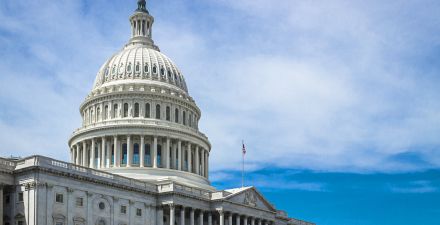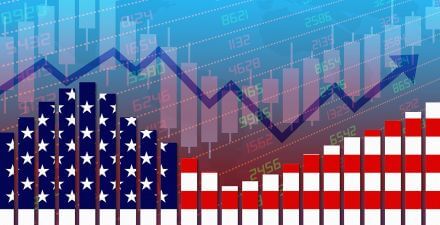A temporary increase in inflation is not a long-run threat to U.S. economic growth and prosperity

After a decade of below-target rates of inflation and the widespread fear of a Japanese-style prolonged economic stagnation with low inflation and zero growth, the incipient economic recovery in the United States from the coronavirus recession is suddenly turning the tables on the debate about inflation.
In May 2021, the Consumer Price Index registered inflation running at 5 percent, the highest reading in a decade for this broad measure of prices—so high that some observers worry about strong and sustained inflation and reference the stagflationary period of the 1970s. At the same time, the Federal Reserve is largely downplaying these concerns, so much so that in late June, Fed Chair Jerome Powell argued before Congress that “it is very, very unlikely” that the United States will face strong inflationary pressures going forward.
Prolonged periods of high inflation do have direct and immediate effects on the macroeconomy and also the potential for more subtle effects of further increasing economic inequality and crimping more sustainable and more equitable growth. Indeed, because many low-income and middle-class households, including many households of color, spend most of their income over the course of their everyday lives, prolonged price increases would affect them more than wealthier households, which save part of their income in real assets whose returns are shielded from inflation.
So, ultimately, what should policymakers really expect to happen to inflation over the next 2 to 5 years? The answer is important, as the Biden administration and the U.S. Congress debate the merits of the proposed infrastructure packages to address fragilities in the U.S. economy and move it toward more stable and sustainable economic growth.
Before focusing our discussion on the plausible and implausible drivers and effects of inflation going forward, we need to stress that the recent 5 percent inflation rate appears much less concerning once we account for what economists call the base rate effect—the price level 12 months ago, in the midst of a pandemic recession in which demand was artificially low due to lockdown measures and inflation was unusually depressed. As this base rate effect vanishes over the next few months—due to the sharp drop in the price level early in the recession partially reversing in the second half of 2020—then, all else being equal, policymakers should expect more moderate Consumer Price Index inflation readings going forward.
But there still remain four very relevant potential drivers of inflation over the next 2 years:
- Demand pressures
- Supply chain disruptions
- Labor market pressures
- Inflation expectations
We’ll examine in this column the extent to which these four factors might or might not be relevant in the current situation.
Demand pressures
Inflation can result when demand for goods and services outstrips suppliers’ ability to produce the desired goods and services to such an extent that permanent price increases are needed to bring the market to a new equilibrium. These dynamics, at first glance, seem to fit the economic recovery from the coronavirus pandemic, during which many suppliers were forced to shut down and needed time to bring production back to normal levels. But those supply chains are now recovering.
Demand pressure was also seemingly further fueled by fiscal and monetary policy interventions aimed at alleviating the most immediate negative impacts of the pandemic and resulting recession. Direct state and federal transfers in the form of direct payments to U.S. families, extended Unemployment Insurance, and emergency supplemental UI benefits, among other recession-fighting policies, ensured that households in which the breadwinners suddenly lost their jobs could maintain, at least in part, their purchasing power and repay their debts.
Yet these fiscal and monetary pressures were one-off interventions. A large majority of households might have received income transfers even when they were not facing large drops in their disposable income based on the high income thresholds used to target the program, such as a joint income of more than $160,000 for married couples. Paired with enhanced precautionary savings motives and limited opportunities to spend on leisure and travel during the pandemic, U.S. households’ savings did surge from a rate of 8.3 percent in February 2020 to 33.7 percent in April 2020 and 27.7 percent in June 2021.
This accumulation of higher savings, paired with new spending opportunities and the reopening of the U.S. economy, made the scope for demand pressure very concrete. Indeed, new car and home sales are at their highest levels since before the Great Recession of 2007–2009.
The ultimate question is whether these demand forces are a substantial concern in terms of inflation over the next 2 years. We find it unlikely. Whereas demand pressure will certainly impact prices in the short run, the stock of household savings accumulated over the past year and a half is limited, and suppliers will be able to adjust production to scale in a few months. What’s more, the delayed spending during the pandemic was primarily for services, rather than durable goods, which means the economy can only make up so much lost ground on delayed services spending.
Overall, then, there is no compelling reason to expect a long-lasting demand pressure on prices.
Supply chain disruptions
Moving to the supply side of the U.S. economy, inflation can also arise when firms experience increases in the costs of production—for example, of their intermediate inputs—or those costs that firms often pass onto their customers depending on pricing strategies and profit margin considerations. Global supply chains, whereby crucial components of finished goods are provided by suppliers around the world at greatly reduced costs, have been on the rise over the past several decades but were severely disrupted by pandemic-related transportation restrictions and the shutdown of production sites in response to the pandemic-induced public health crisis. This severely impacted the cost of outsourcing through global supply chains and hence put upward pressure on consumer prices.
For instance, car manufacturers currently face severe bottlenecks in supply chains due to the shortage of semiconductors, which increase their input costs and pressure them to increase the consumer prices of their finished goods. Another example is medical supplies that are largely produced in Southeast Asia, which was largely shut down during the early parts of the pandemic, resulting in stock shortages and price increases.
Similar to the demand pressures discussed above, though, there is little reason to believe that supply-side disruptions will last beyond the time when global supply chains will again be fully operative. Therefore, we do not see how supply chain disruptions might impact inflation in the medium to long term.
Take the price of lumber. Due to the increased demand for construction, timber prices almost doubled in the first half of 2021. Many observers argued that we would face sustained price pressure for lumber and other commodities. Yet, as of June 2021, the price of timber is pretty much back to its January 2021 level. Similarly, while the price of financial contracts for Crude Oil WTI futures—the most actively traded crude oil contract—is at levels previously seen in 2018, there is no reason to believe that prices will keep going up in the medium run.
Labor market pressures
Another way through which costs of production for firms can increase is through higher wages for workers. Of course, higher wages will ensure that consumers’ purchasing power is sustained, but waves of wage increases could be inflationary. So, let’s look at the details.
With demand picking up across the U.S. economy as it reopens, many businesses are starting to increase their hiring. Total unfilled vacancies have reached their highest level since 2000. At the same time, the overall U.S. labor market still has a substantial amount of slack—that is, a large amount of workers who have not yet returned to the workforce. The June 2021 employment-to-population ratio stands at 58 percent, recovering from a low of 51.3 percent in April 2020 but still substantially below the pre-pandemic level of 61.1 percent in February 2020.
Moreover, the pre-pandemic level was still below the employment-to-population ratio before the Great Recession of 2007–2009. Hence, the U.S. labor market is still a long way off from a full recovery and has ample slack to absorb additional labor demand, despite the unemployment rate decreasing from 14.8 percent in April 2020 to 5.8 percent in May 2021.
This latter point is important because macroeconomists typically argue that slack in the economy affects realized inflation due to the Phillips curve—the relationship between inflation and the extent to which the resources in the economy are utilized. Ample slack implies little price pressure.
Recent evidence indicates a flatter Phillips curve, which means that even if the economy were running at full capacity, there is little chance for sustained inflationary pressure to materialize. At the same time, we also observe that the pandemic resulted in a wave of early retirements alongside many workers who are not willing to work in contact-intense industries because of health concerns. This reduction in labor supply can result in temporary labor shortages and higher hiring bonuses and wages. These effects can result in higher price levels—for example, for restaurants—but they are unlikely to result in sustained inflationary pressures because of the overall amount of slack in the U.S. economy.
Inflation expectations
Expectations are a crucial determinant for virtually all decisions consumers make in their daily lives, such as savings-consumption choices, wage-bargaining decisions, and investment choices. Expectations matter for inflation because if consumers think prices are going to rise in the future, then they are more likely to take advantage of what seem like discounted prices today—behavior which itself bids up prices, leads to calls for higher wages, and creates a self-fulfilling feedback loop.
The Federal Reserve focuses on core inflation—overall inflation excluding volatile price series such as groceries and energy—because core inflation tends to better predict sustained inflationary pressures. The Fed also assumes that households have well-anchored inflationary expectations close to their annual target of 2 percent, on average. By contrast, recent research shows that households think about inflation in a very different way than what the Fed assumes.
Rather than focusing on the change in prices of an overall consumption basket and weighting those price changes by their expenditure shares, consumers tend to think about the prices of concrete goods and services they face in their daily lives. In particular, most consumers focus on the price changes of salient goods, such as gas, and the price changes of goods they purchase frequently, such as groceries.
Overheating is not a concern for the U.S. economy
April 26, 2021
What’s more, consumers tend to assign a larger weight to price increases, relative to similar-sized price decreases, when forming their inflation expectations. And these sources of divergence between perceived inflation and official inflation measures are more relevant for women, who tend to be more exposed to grocery prices than men due to traditional gender roles.
Now, with demand picking up, it is evident there is a substantial increase in gas prices at the pump and highly volatile grocery prices, both of which are transmitted into a large spike in household inflation expectations. The expected median inflation rate 1 year from now, as reported in the New York Fed Survey of Consumer Expectations, hit 4 percent in May, the highest number on record.
The median, however, masks a long right tail—statistical parlance for the existence of households with expectations substantially above the median—with average expected inflation across all U.S. households being substantially higher. The average number also masks substantial heterogeneity across demographics. The within-group average for the oldest age group is an inflation rate of 4.8 percent, 1.6 percentage points higher than for the lowest age group. Moreover, those with lower levels of education, on average, expect an inflation rate of 5.6 percent, 2.2 percentage points higher than the expected rate for the college-educated.
Then, there is recent research on what is known as the Euler equation, which explains why there might be some additional, but temporary, price pressures, according to a NBER working paper co-authored by one of us and also a forthcoming working paper in the Review of Financial Studies co-authored by both of us and Daniel Hoang at the Karlsruhe Institute of Technology. But to the extent that heighted inflation expectations result in increased demand pressure in the short run, more permanent price pressures might only occur if the U.S. household sector demanded higher wages due to heighted inflation expectations, which we haven’t seen materializing in recent decades of low and stable inflation and which would require sustained pressure to make up for mostly stagnant wages over the past several decades.
Conclusion
Taken together, the four highly debated factors that might influence inflation in the coming months do not appear to imply sustained inflationary pressure in the medium to long term. Hence, we do not see the need for the Federal Reserve to take policy actions in the short run because of sustained inflationary pressure. But more guidance might be needed by the Fed on how to interpret their new policy framework.
Moreover, given fading inflationary pressure in the medium run, we do not see any evidence for the Biden administration to change its policy agenda because of mounting inflation on the horizon. The pros and cons of those policies should be discussed on their merits rather than on their impact on inflation, which we believe will be temporary.
— Francesco D’Acunto is an assistant finance professor at the Carroll School of Management at Boston College. Michael Weber is an associate professor of finance at the University of Chicago’s Booth School of Business.







